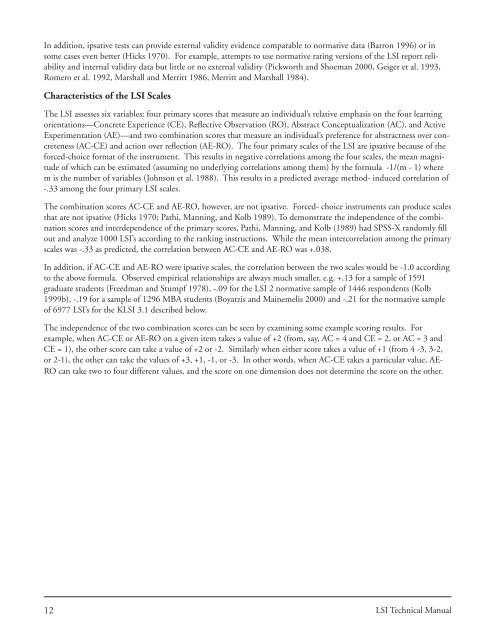The Kolb Learning Style Inventory—Version 3.1 2005 - Whitewater ...
The Kolb Learning Style Inventory—Version 3.1 2005 - Whitewater ...
The Kolb Learning Style Inventory—Version 3.1 2005 - Whitewater ...
You also want an ePaper? Increase the reach of your titles
YUMPU automatically turns print PDFs into web optimized ePapers that Google loves.
In addition, ipsative tests can provide external validity evidence comparable to normative data (Barron 1996) or in<br />
some cases even better (Hicks 1970). For example, attempts to use normative rating versions of the LSI report reliability<br />
and internal validity data but little or no external validity (Pickworth and Shoeman 2000, Geiger et al. 1993,<br />
Romero et al. 1992, Marshall and Merritt 1986, Merritt and Marshall 1984).<br />
Characteristics of the LSI Scales<br />
<strong>The</strong> LSI assesses six variables: four primary scores that measure an individual’s relative emphasis on the four learning<br />
orientations—Concrete Experience (CE), Refl ective Observation (RO), Abstract Conceptualization (AC), and Active<br />
Experimentation (AE)—and two combination scores that measure an individual’s preference for abstractness over concreteness<br />
(AC-CE) and action over refl ection (AE-RO). <strong>The</strong> four primary scales of the LSI are ipsative because of the<br />
forced-choice format of the instrument. This results in negative correlations among the four scales, the mean magnitude<br />
of which can be estimated (assuming no underlying correlations among them) by the formula -1/(m - 1) where<br />
m is the number of variables (Johnson et al. 1988). This results in a predicted average method- induced correlation of<br />
-.33 among the four primary LSI scales.<br />
<strong>The</strong> combination scores AC-CE and AE-RO, however, are not ipsative. Forced- choice instruments can produce scales<br />
that are not ipsative (Hicks 1970; Pathi, Manning, and <strong>Kolb</strong> 1989). To demonstrate the independence of the combination<br />
scores and interdependence of the primary scores, Pathi, Manning, and <strong>Kolb</strong> (1989) had SPSS-X randomly fi ll<br />
out and analyze 1000 LSI’s according to the ranking instructions. While the mean intercorrelation among the primary<br />
scales was -.33 as predicted, the correlation between AC-CE and AE-RO was +.038.<br />
In addition, if AC-CE and AE-RO were ipsative scales, the correlation between the two scales would be -1.0 according<br />
to the above formula. Observed empirical relationships are always much smaller, e.g. +.13 for a sample of 1591<br />
graduate students (Freedman and Stumpf 1978), -.09 for the LSI 2 normative sample of 1446 respondents (<strong>Kolb</strong><br />
1999b), -.19 for a sample of 1296 MBA students (Boyatzis and Mainemelis 2000) and -.21 for the normative sample<br />
of 6977 LSI’s for the KLSI <strong>3.1</strong> described below.<br />
<strong>The</strong> independence of the two combination scores can be seen by examining some example scoring results. For<br />
example, when AC-CE or AE-RO on a given item takes a value of +2 (from, say, AC = 4 and CE = 2, or AC = 3 and<br />
CE = 1), the other score can take a value of +2 or -2. Similarly when either score takes a value of +1 (from 4 -3, 3-2,<br />
or 2-1), the other can take the values of +3, +1, -1, or -3. In other words, when AC-CE takes a particular value, AE-<br />
RO can take two to four different values, and the score on one dimension does not determine the score on the other.<br />
12 LSI Technical Manual


